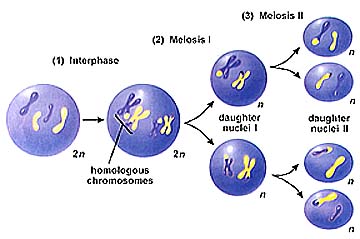Meiotic Fictions: Hybridity and the Reproduction of the New
Nicole Matos

[1] To grasp meiosis in its literal state as a biological process requires some explanation. Both meiosis's physical operations and its status as a fundamentally transformational cellular innovation — not infrequently characterized as one of the "most significant evolutionary events in the history of our planet" (Fenwick 203) — are best illustrated through comparison with its simpler and somewhat oppositional precursor, mitosis. Mitosis is most simply understood as a particular form of cloning in which an individual cell forms into two genetically identical copies of itself. A rapid, exponential replication — whereby one cell begets two copies; and those two, four; and those four, eight; and so on, all identical — mitosis is what produces all cells in asexually reproducing species and almost all cells even in sexually reproducing species. [9] Meiosis, in contrast, is the comparatively rare mechanism by which the sex cells, or gametes, of sexually reproducing species are produced in a form appropriate for eventual fertilization. Occurring in humans only during the creation of egg cells in females and of sperm cells in males, meiosis is the cellular transformation that makes sexual reproduction possible. The distinguishing feature of meiosis, and thus of sexual reproduction, is genetic recombination — the reshuffling of parental genes into differently ordered groupings.
[2] The physical process of meiosis begins with the same raw material that mitosis does — a single body cell with a full complement of paired chromosomes. In humans, this full or diploid set consists of 23 pairs, often represented as (and when untangled, neatly organized, and photographed actually looking a bit like) pairs of Xs side-by-side. [10] Paired chromosomes are known as "homologues" because each contains similar genetic information. The similarity is only one of basic function, however, and not of individualized expression— to oversimplify for the sake of example, both homologues may "list" genes whose function involves the development of eyes, but each may "describe" differently colored eyes. That is, as Frankin W. Stahl puts it, "Homologous chromosomes are by no means identical, and therein may lie the importance of genetic recombination" (91).
[3] If sex cells were created through mitosis, as other body cells are, each successive offspring of sexual reproduction would have double the number of original chromosomes in his or her cells; for humans, a father's 23 pairs plus a mother's 23 pairs. This model does not appear widely practicable in nature; fertile and viable species generally require constancy in chromosome number. To enable the eventual production of a two-parent offspring with the correct number of chromosomes for that species, forming sex cells undergo meiosis to create "daughter cells" of only 23 individual chromosomes. At fertilization, when one individual's sex cell fuses with the sex cell of another, the chromosome pairings will be restored.
[4] Clearly, the possibility of producing offspring with genetic information from two parents already introduces great potential for genetic diversity. It becomes almost certain that children derived from sexual reproduction will be at least somewhat genetically different from either of their parents. The more astounding and evocative aspect of meiosis, however, is not that it functions to reduce chromosome number and thus make sexual reproduction feasible, but how this is enacted. Counterintuitively, cells undergoing meiotic division don't jettison one "extraneous" chromosome at random from each pair, but instead enact a complex process of exchange and conjunction, grafting and transplantation, between paired chromosomes. The arms of each pair of Xs begin intersecting each other at various points of chiasmus — what biologists more casually call "crossing-over." The crossed and recrossed chromosome arms "stick" at these points of chiasmus, then break off, resulting in new individual chromosomes composed of redistributed segments of the old ones. [11]
[5] The implications of this process on genetic diversity and evolution can hardly be exaggerated; as Julie Fenwick writes, "Since there are thousands of human genes, the possible number of permutations resulting from this recombination greatly exceeds the total number of people who have ever existed" (204). But the process has numerous and transformative implications too as a shape for thinking through more abstract and humanistic questions: of hybridity and amalgamation; individuality and heritage; continuity and discontinuity; reproduction and replication; and the past and the future.
[9] Mitosis in bone cells, for example, is what allows children to grow larger; mitosis in skin cells repairs cuts or tears.
[10] See Figure 5.5, page 89, Biology: Science and Life. ed. Michael R. Cummings. Minneapolis: West Publishing, 1996. Shows the human karyotype.
[11] See Figure 9.16, page 205, Life: The Science of Biology. ed. William Purves, Gordon Orians and H.Craig Heller. Salt Lake City: W.H. Freeman, 1995. Shows chromosomes crossing-over.
